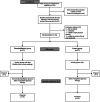App-based telerehabilitation program for older adults on waiting list for physiotherapy after hospital discharge: a feasibility pragmatic randomized trial
- PMID: 38961470
- PMCID: PMC11221181
- DOI: 10.1186/s40814-024-01521-4
App-based telerehabilitation program for older adults on waiting list for physiotherapy after hospital discharge: a feasibility pragmatic randomized trial
Abstract
Background: Inactivity while waiting for outpatient physiotherapy worsens the physical deconditioning of older adults after hospital discharge. Exercise programs can minimize the progression of deconditioning. In developing countries, telerehabilitation for older adults on the waiting list is still in the early stages. This study aimed to evaluate the feasibility of the study procedures of a telerehabilitation program for older adults waiting for outpatient physiotherapy after hospital discharge.
Methods: This pragmatic randomized controlled trial recruited older adults (≥ 60 years) with several clinical diagnoses on the waiting list for outpatient physiotherapy in the Brazilian public health system after hospital discharge. The telerehabilitation group (n = 17) received a personalized program of multicomponent remote exercises using a smartphone app. The control group (n = 17) followed the usual waiting list. We assessed recruitment and dropout rates, safety, adherence, and satisfaction. The preliminary effects were verified on clinical outcomes.
Results: We recruited 5.6 older adults monthly; dropouts were 12%. No serious adverse events were associated with the telerehabilitation program. The weekly adherence was 2.85 (1.43) days, and in 63.3% of the weeks the participants were enrolled, they performed the exercise program at least twice a week. Participants rated the telerehabilitation program as 9.71 (0.21), and the safety of remote exercises without professional supervision as 8.6 (2.2) on a 0-10 scale.
Conclusions: The telerehabilitation program using a smartphone app was safe and presented high participants' satisfaction and adequate adherence, recruitment, and dropout rates. Therefore, the definitive study can be conducted with few modifications.
Trial registration: Brazilian Registry of Clinical Trials (ReBEC), RBR-9243v7. Registered on 24 August 2020. https://ensaiosclinicos.gov.br/rg/RBR-9243v7 .
Keywords: Deconditioning; Geriatrics; Hospitalization; Rehabilitation; Telehealth.
© 2024. The Author(s).
Conflict of interest statement
The authors declare that they have no competing interests.
Similar articles
-
Telerehabilitation program for older adults on a waiting list for physical therapy after hospital discharge: study protocol for a pragmatic randomized trial protocol.Trials. 2021 Jul 13;22(1):445. doi: 10.1186/s13063-021-05387-2. Trials. 2021. PMID: 34256830 Free PMC article.
-
Effects of a periodized circuit training protocol delivered by telerehabilitation compared to face-to-face method for knee osteoarthritis: a protocol for a non-inferiority randomized controlled trial.Trials. 2021 Dec 6;22(1):887. doi: 10.1186/s13063-021-05856-8. Trials. 2021. PMID: 34872597 Free PMC article.
-
The Use of Telerehabilitation to Improve Movement-Related Outcomes and Quality of Life for Individuals With Parkinson Disease: Pilot Randomized Controlled Trial.JMIR Form Res. 2024 Jul 31;8:e54599. doi: 10.2196/54599. JMIR Form Res. 2024. PMID: 39083792 Free PMC article.
-
Real-time video telerehabilitation shows comparable satisfaction and similar or better attendance and adherence compared with in-person physiotherapy: a systematic review.J Physiother. 2024 Jul;70(3):181-192. doi: 10.1016/j.jphys.2024.06.001. Epub 2024 Jun 15. J Physiother. 2024. PMID: 38879432
-
Patient and Parent Experiences with Group Telerehabilitation for Child Survivors of Acute Lymphoblastic Leukemia.Int J Environ Res Public Health. 2021 Mar 31;18(7):3610. doi: 10.3390/ijerph18073610. Int J Environ Res Public Health. 2021. PMID: 33807179 Free PMC article. Review.
References
Grants and funding
LinkOut - more resources
Full Text Sources



